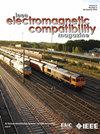Analysis and Integration of Chaotic Gaussian PWM and Passive Filter for Conducted EMI Suppression
IF 2.5
3区 计算机科学
Q3 ENGINEERING, ELECTRICAL & ELECTRONIC
IEEE Transactions on Electromagnetic Compatibility
Pub Date : 2025-06-18
DOI:10.1109/TEMC.2025.3571194
引用次数: 0
Abstract
As wide bandgap semiconductor devices continue to be adopted, power converters can now operate at higher switching frequencies and power densities. However, this progress presents new challenges in controlling electromagnetic interference (EMI). Traditional passive EMI filters (PEFs) effectively suppress EMI, but are constrained by their size and weight, limiting power density improvements in converters. To address these issues, this article introduces an innovative strategy combining chaotic pulsewidth modulation (PWM) with Gaussian waveforms to produce chaotic Gaussian PWM (CGPWM). While CGPWM demonstrates excellent performance in reducing high-frequency EMI, stringent electromagnetic compatibility standards still necessitate the use of robust passive filters. Accordingly, this article designs a PEF based on CGPWM, aimed at enhancing EMI suppression while significantly reducing the size and inductance of common-mode (CM) inductors. By examining the spectrum reduction effects of square, Gaussian, and chaotic Gaussian waveforms, an optimized PEF is developed based on CGPWM. Experimental results reveal that this integrated approach reduces CM inductor volume by over 74.28% and inductance by 60%, achieving up to 50 dB of EMI attenuation. These outcomes highlight the potential of combining CGPWM and PEF for effective EMI suppression and minimized filter size, making it a promising solution for high-density power electronics.混沌高斯脉宽调制与无源滤波器在传导电磁干扰抑制中的分析与集成
随着宽带隙半导体器件的不断采用,功率转换器现在可以在更高的开关频率和功率密度下工作。然而,这一进展对控制电磁干扰(EMI)提出了新的挑战。传统的无源EMI滤波器(pef)有效地抑制了EMI,但受其尺寸和重量的限制,限制了转换器功率密度的提高。为了解决这些问题,本文介绍了一种将混沌脉宽调制(PWM)与高斯波形相结合的创新策略,以产生混沌高斯脉宽调制(CGPWM)。虽然CGPWM在减少高频EMI方面表现出色,但严格的电磁兼容性标准仍然需要使用强大的无源滤波器。因此,本文设计了一种基于CGPWM的PEF,旨在增强EMI抑制,同时显著减小共模(CM)电感的尺寸和电感。通过对方形、高斯和混沌高斯波形的频谱缩减效果的研究,提出了一种基于CGPWM的优化PEF。实验结果表明,该集成方法将CM电感体积减小74.28%以上,电感减小60%,实现高达50 dB的电磁干扰衰减。这些结果突出了将CGPWM和PEF结合起来有效抑制EMI和最小化滤波器尺寸的潜力,使其成为高密度电力电子器件的有前途的解决方案。
本文章由计算机程序翻译,如有差异,请以英文原文为准。
求助全文
约1分钟内获得全文
求助全文
来源期刊
CiteScore
4.80
自引率
19.00%
发文量
235
审稿时长
2.3 months
期刊介绍:
IEEE Transactions on Electromagnetic Compatibility publishes original and significant contributions related to all disciplines of electromagnetic compatibility (EMC) and relevant methods to predict, assess and prevent electromagnetic interference (EMI) and increase device/product immunity. The scope of the publication includes, but is not limited to Electromagnetic Environments; Interference Control; EMC and EMI Modeling; High Power Electromagnetics; EMC Standards, Methods of EMC Measurements; Computational Electromagnetics and Signal and Power Integrity, as applied or directly related to Electromagnetic Compatibility problems; Transmission Lines; Electrostatic Discharge and Lightning Effects; EMC in Wireless and Optical Technologies; EMC in Printed Circuit Board and System Design.

 求助内容:
求助内容: 应助结果提醒方式:
应助结果提醒方式:


